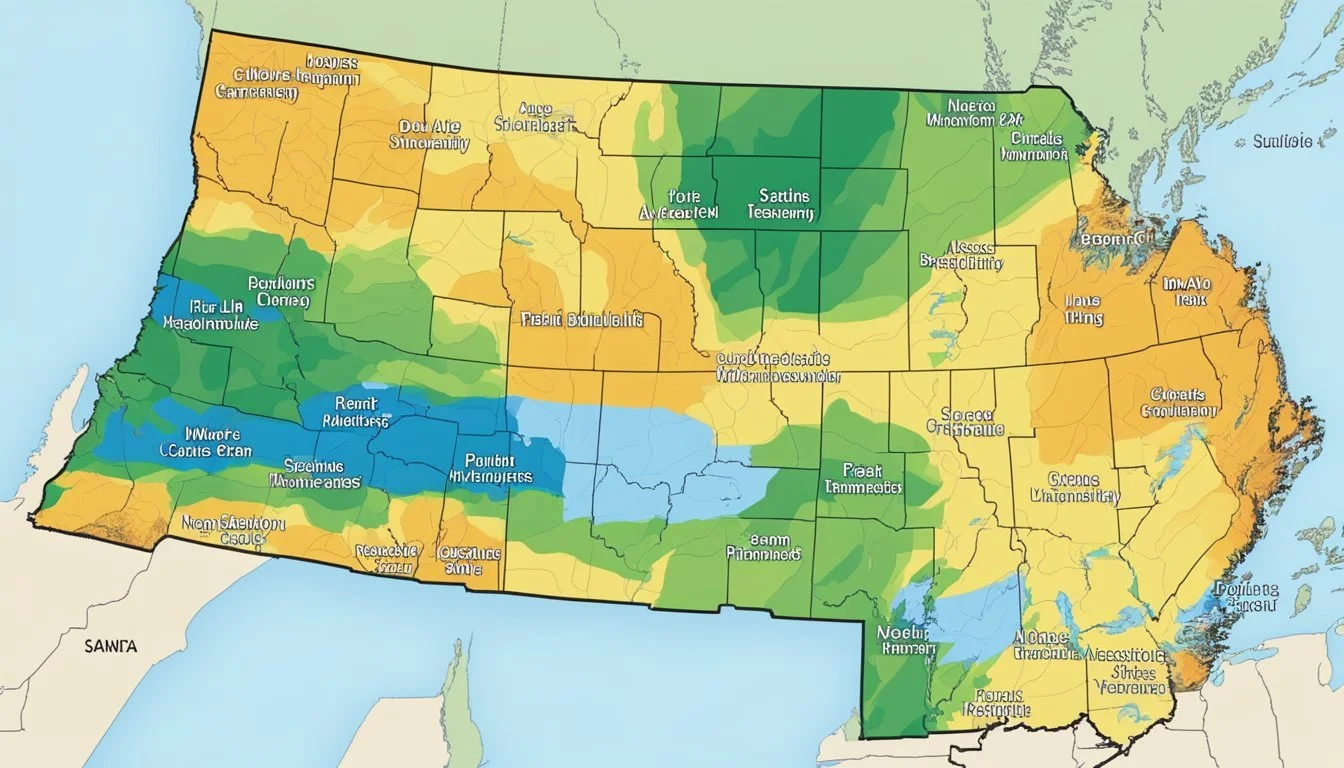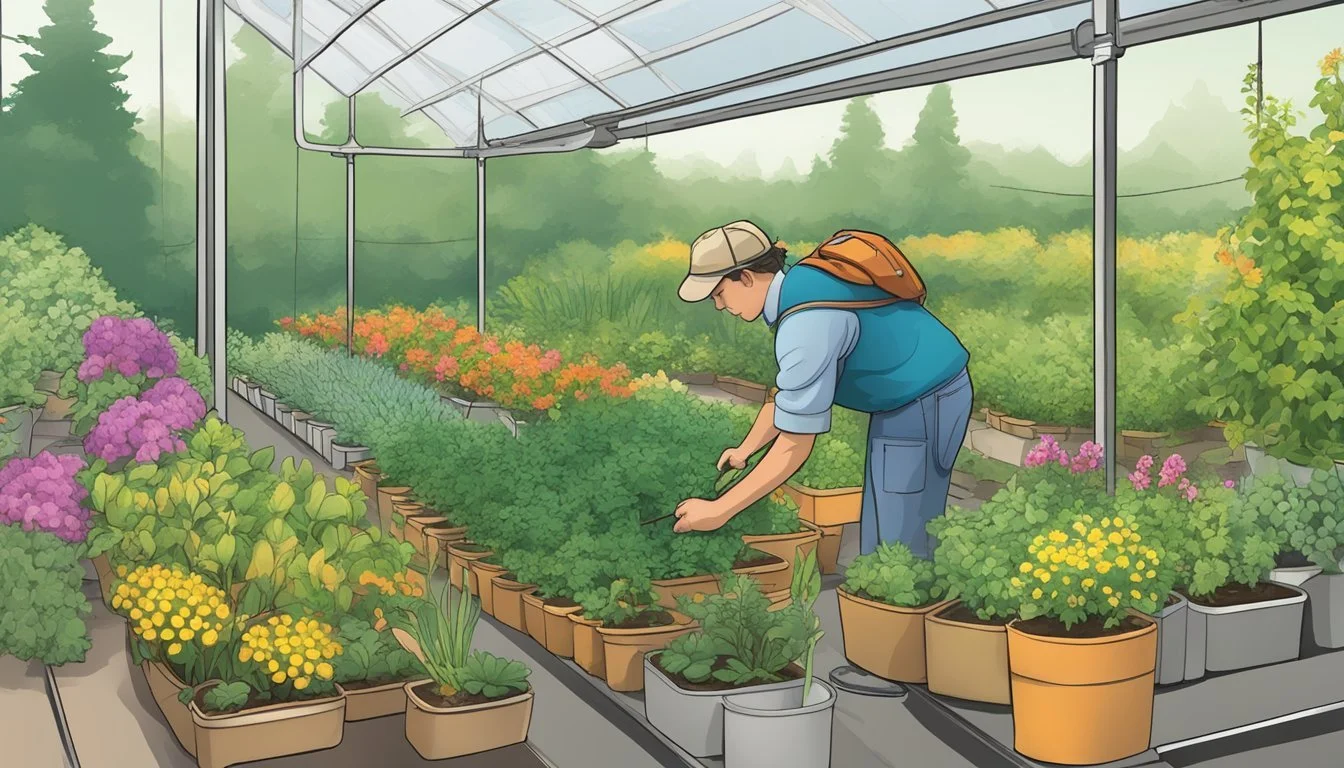USDA Hardiness Zones in New Hampshire
A Guide to Planting Success
The United States Department of Agriculture (USDA) Hardiness Zones are a crucial tool for gardeners and agriculturalists in New Hampshire to understand what plants will thrive in their local climate. These zones are delineated by the average annual extreme minimum winter temperature, with each zone representing a range of these temperatures. The 2023 USDA Plant Hardiness Zone Map is the most current standard guide, updated with extensive climatological data to aid in selecting perennial plants best suited for a location’s conditions.
In New Hampshire, the USDA zones vary significantly across the state due to its varied geography and climate. The USDA Hardiness Zones in New Hampshire range from the colder zones 3b through to the warmer edge of 6b. These zones reflect the diverse growing conditions, from the northern reaches to the more temperate southern areas, guiding local growers in making informed planting decisions. Understanding these zones is essential for successful gardening and crop production throughout the state.
The hardiness zones of New Hampshire not only direct what types of perennial plants may survive the winter but also inform timing for planting schedules, as well as the selection of species for landscaping and commercial agriculture. The zones are periodically updated, incorporating feedback from botanists and over three decades of weather data, indicative of changing climate patterns that may shift the boundaries of these zones. The updated map is a valuable resource, ensuring that New Hampshire's planting strategies adapt with the times.
Understanding USDA Hardiness Zones
The USDA Plant Hardiness Zone Map is an invaluable tool, defining regions where specific plants are most likely to thrive. It takes into consideration the climatic conditions essential for plant survival and growth.
Defining Hardiness Zones
Hardiness zones, or climate zones, are geographic areas categorized by the range of climatic conditions pertinent to plant growth and survival. Specifically, these zones are defined by the average annual extreme minimum temperature. The USDA has delineated these regions on the USDA Plant Hardiness Zone Map, where the United States is divided into zones by 10-degree Fahrenheit increments, with 5-degree Fahrenheit half zones further refining the classifications.
Role of the USDA
The United States Department of Agriculture (USDA) is responsible for the creation and update of the hardiness zones. They employ data from weather stations across the country to provide the most accurate and up-to-date information that reflects changes in climate patterns. The map's precision guides both hobbyists and professional growers in selecting plants for their gardens.
Importance for Gardeners and Growers
For gardeners and growers, understanding the USDA hardiness zones is crucial. It allows them to make informed decisions about which plants can survive and flourish in their gardens. The zones provide a foundation for selecting species and varieties that stand the best chance of thriving in the local conditions. This localized data removes much of the guesswork from gardening, thereby increasing the likelihood of successful plant growth and yield in their gardens.
New Hampshire's Climatic Overview
New Hampshire experiences a range of climatic conditions, which can be quite variable, with its inland areas generally experiencing colder temperatures than the coastal regions. The understanding of this state's winter temperatures and the impact of climate change is essential for agriculture, gardening, and ecological planning.
Winter Temperature Ranges
In New Hampshire, winter temperatures vary considerably, influenced by geography and altitude. According to the 1990 Hardiness Zone Map, the state's hardiness zones ranged from 3b to 5b, indicating minimum temperatures between -35°F to -10°F. As observed by Gardening Know How, recent updates have divided New Hampshire into six main zones:
Zone 3b: -35°F to -30°F
Zone 4a: -30°F to -25°F
Zone 4b: -25°F to -20°F
Zone 5a: -20°F to -15°F
Zone 5b: -15°F to -10°F
Zone 6a: -10°F to -5°F
Impact of Climate Change
Climate change introduces warming trends that shift hardiness zones northward, a phenomenon depicted in the 2023 USDA Plant Hardiness Zone Map. These shifts affect the types of plants that can thrive in New Hampshire, with evidence suggesting a trend towards milder winters. There is a consensus in the scientific community that climate change is influencing regional climates, prompting updates to hardiness zone maps to accommodate changes in extreme minimum winter temperatures.
Hardiness Zones in New Hampshire
New Hampshire's diverse climate is segmented into several USDA hardiness zones, making it essential for gardeners to understand the variances to successfully cultivate plants.
Regional Zone Variations
The state's topography leads to significant regional differences in climate that are reflected in the hardiness zones. The zones range from 3b in the mountainous areas to 6b in the southern region. These zones indicate the extreme minimal temperatures one can expect, a critical factor for determining plant survival and growth.
Key Locations and Their Zones
Acworth and Albany are characterized by a colder zone, specifically Zone 5b with temperatures reaching as low as -15°F. On the other hand, Alexandria is in Zone 4b, where the temperature drops to -25°F. For a more detailed analysis of each location's zone, one can refer to the New Hampshire 1990 USDA Hardiness Zone Map.
Location: Acworth
Hardiness Zone: Zone 5b
Location: Albany
Hardiness Zone: Zone 4b
Location: Alexandria
Hardiness Zone: Zone 4b
This data is instrumental for gardeners to understand which perennial plants are best suited for their region. The hardiness zones provide a foundational guide for landscaping and agriculture throughout the various cities in New Hampshire.
Utilizing the Plant Hardiness Zone Map
The USDA Plant Hardiness Zone Map is a crucial tool for growers and gardeners. This guide helps in selecting the most suitable plants for their specific location in New Hampshire, based on the average annual extreme minimum temperature.
Understanding the Map Layout
The layout of the USDA Hardness Zone Map is designed for simplicity and clarity. It segments the United States into zones that reflect the average minimum winter temperatures. Specifically, these zones range from 1 through 13, with each having further sub-divisions 'a' and 'b' to provide more granular temperature detail. For instance, a tag labeled "5a" on the map signifies a somewhat warmer microclimate than "5b."
Finding Your Specific Zone
To determine where New Hampshire falls on the map, one might look for locations and their corresponding zones. The state generally ranges within Zones 3b through 6a, allowing gardeners to tailor their plant selections to the climate they reside in. Finding one's specific zone requires looking up their location and matching it to the coded colored areas on the map, thus informing their planting decisions.
GIS and the USDA Map
Geographic Information Systems (GIS) provide a sophisticated means to interact with the Plant Hardiness Zone Map. Through GIS, users can explore spatial data related to planting zones with enhanced precision. This integration allows for the creation of interactive maps where individuals can input an address or zip code to find their precise hardiness zone, facilitating targeted and successful gardening and research initiatives in the state of New Hampshire.
Selecting Plants for New Hampshire Gardens
Gardeners in New Hampshire must choose plants carefully to ensure they thrive in the region's diverse USDA Hardiness Zones. Perennial plants suited to the local climate will establish more readily, offering a sustainable and attractive garden year after year.
Choosing Suitable Perennials
For perennial plants, gardeners should target species known to perform well in their specific hardiness zone. New Hampshire spans a range from zone 3b to zone 6b, influencing the selection of perennials. Popular perennials like daylilies, hostas, and rudbeckia are solid choices for more temperate zones like 5b and 6a, which can be found in southern parts of the state. Conversely, for the colder areas encompassing zones 3b and 4a, alpine plants such as Sedum or Dianthus are more appropriate, as they can withstand harsher temperatures.
It is essential for growers to refer to the USDA Plant Hardiness Zone Map when planning their perennial gardens. By matching plants to the zones indicated on the map, they increase their chances of gardening success exponentially.
Considering Trees and Shrubs
Trees and shrubs are long-term investments in any garden, hence selecting species that align with New Hampshire's climate is critical. Although a variety of maples and oaks can adapt across several zones, narrow selections by choosing local varieties like the paper birch for colder zones or the Sugar Maple for intermediate zones. For shrubs, options such as the versatile boxwood or flowering hydrangeas can provide structure and color to gardens in zones 5a to 6b.
The list of hardiness zones for several locations in New Hampshire found on Plantmaps assists in tailoring tree and shrub choices to specific regions. This tool is invaluable for ensuring that trees and shrubs have the best chance to thrive given the local conditions.
Methodology Behind Zone Updates
The updates to the USDA Hardiness Zones are grounded in rigorous analysis and incorporate the latest climate data. They reflect a comprehensive assessment of the extreme minimum temperatures that plants are expected to withstand.
Analyzing the 30-Year Average
The USDA's methodology centers on a 30-year average of historical weather data, specifically the average annual extreme minimum temperatures. This data collection spans from 1991 to 2020, ensuring that the zones are reflective of both recent trends and historical climatology. The calculations involve compiling temperature data from a multitude of weather stations across the nation, which is then algorithmically adjusted to develop a detailed map down to the microclimate level.
By encompassing three full decades, the USDA ensures that their hardiness zones are not overly influenced by any single event or short-term climate anomaly, but rather present a robust representation of enduring climactic conditions. This method helps gardeners and growers make informed decisions about which plants are likely to thrive in their specific locale.
Recent Changes in Zone Classifications
In the latest updates, adjustments to the plant hardiness zones have been made to capture slight shifts in climate patterns. These revisions include the reclassification of several areas in New Hampshire where portions of the southern part of the state have moved to warmer zones. Through meticulous analysis, the USDA has noted transitional trends in these regions, prompting an update to their zone designation to ensure national consistency and local relevance.
The methods used for revising zone classifications include an in-depth review of the lowest annual winter temperatures, as well as a reevaluation of geographical factors that may influence microclimates. These comprehensive methods facilitate the USDA's delivery of a highly accurate and actionable zone map for the entire country, influencing horticulture practices on both a national and a local scale.
Frequently Asked Questions
Understanding USDA Hardiness Zones is crucial for successful gardening. This section provides answers to common questions about New Hampshire's planting zones.
Which USDA Hardiness Zone does Concord, New Hampshire fall into?
Concord, New Hampshire is classified within USDA Hardiness Zone 5b, with expected extreme winter lows between -15°F and -10°F.
How can I determine the planting zone for my zip code in New Hampshire?
One can determine their specific planting zone by visiting the USDA Plant Hardiness Zone Map and entering their zip code in the provided search tool.
Where can I find a detailed climate zone map for New Hampshire?
Detailed climate zone maps for New Hampshire can be found through resources such as the updated USDA Hardiness Zone Map.
What is the growing zone for Manchester, New Hampshire in terms of gardening?
Manchester, New Hampshire, falls within the USDA Hardiness Zone 5b.
Can you provide a guide to understanding the USDA Zone Map for New Hampshire?
A guide to understanding the USDA Zone Map for New Hampshire is available with insights on various hardiness zones and their significance.
What are the boundaries for Nashua, New Hampshire's plant hardiness zone?
Nashua, New Hampshire, is typically within the USDA Hardiness Zone 5b, similar to Concord and Manchester.








